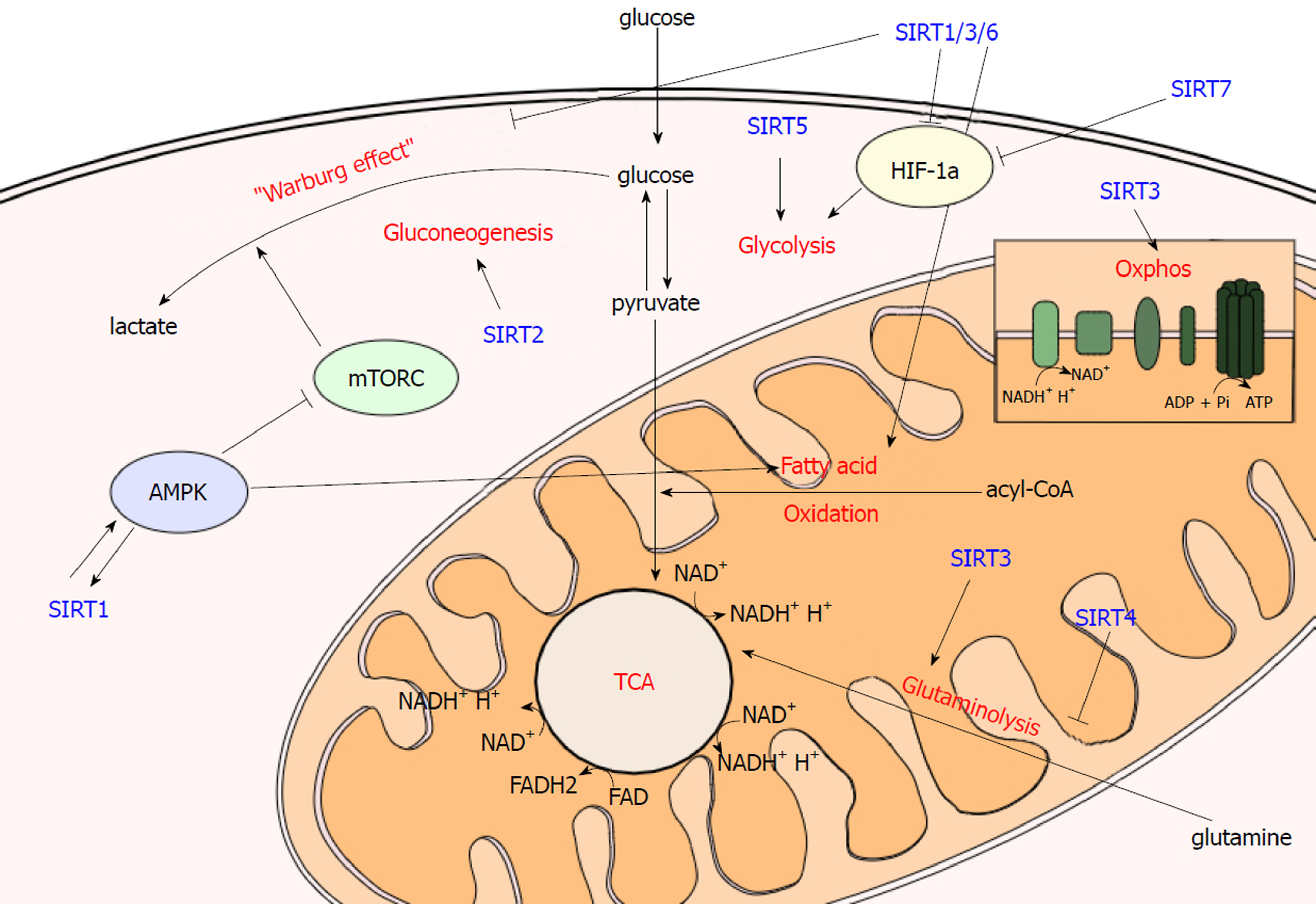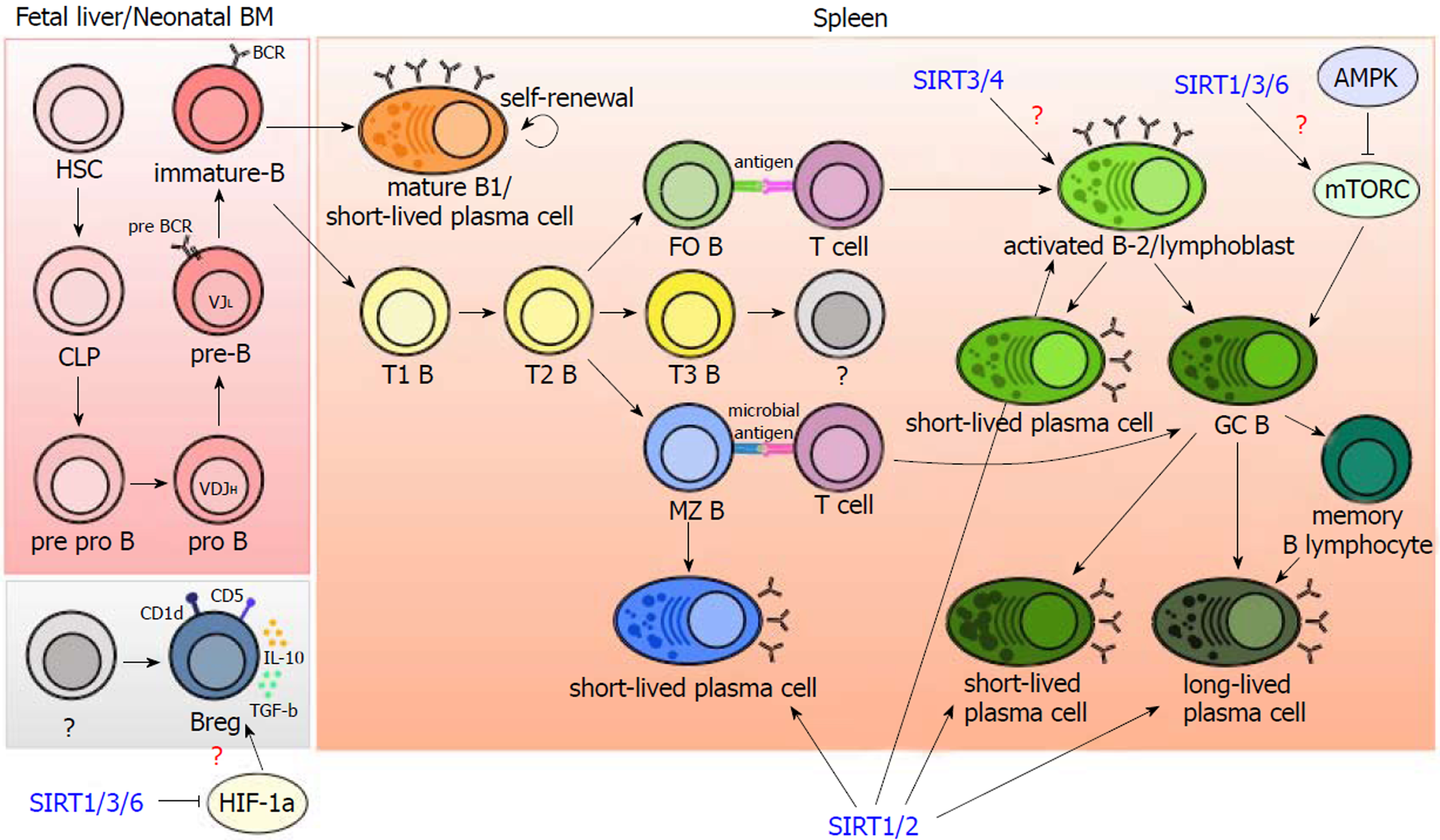Copyright
©The Author(s) 2019.
Figure 1 Sirtuins and metabolism.
SIRTs are metabolic sensors that modulate a variety of metabolic pathways, including glycolysis (Warburg effect), gluconeogenesis, fatty acid oxidation, glutaminolysis, TCA cycle and OXPHOS. SIRTs 1, 3 and 6 restrain the glycolytic pathway through HIF-1α inhibition or direct effects. SIRT3 upregulates OXPHOS pathway by enhancing the activity of the mitochondrial complexes I, II and III and dampening ROS production. SIRT1 is also able to increase the fatty acid oxidation by activating PPAR-α and PGC1-α, while SIRT3 upregulates the fatty acid oxidation upon caloric restriction conditions. SIRT2 induces gluconeogenesis. SIRT3 and 4 activates and inhibits, respectively, the glutaminolysis by regulating the GDH activity. SIRT5 increases glycolysis by increasing the activity of the GAPDH enzyme. SIRT7 can also repress HIF-1α and therefore inhibit transcription of glycolytic genes. At last, SIRT1 performs a positive feedback loop with AMPK, since AMPK rises NAD+ levels in cells, which in turn enhances SIRT1 activity and lastly leads to AMPK activation. AMPK suppresses glycolysis via mTORC1 inhibition and promotes fatty acid oxidation. In the Figure, SIRTs are represented based on their functions only and not by localization. AMPK: AMP-activated protein kinase; GAPDH: Glyceraldehyde 3-phosphate dehydrogenase; GDH: Glutamate dehydrogenase enzyme; HIF-1α: Hypoxia-inducible factor 1-alpha; mTORC1: Target of rapamycin complex 1; NAD+: Nicotinamide adenine dinucleotide; OXPHOS: Oxidative phosphorylation; PGC1-α: Proliferator-activated receptor γ coactivator-1α; PPAR-α: Peroxisome proliferator-activated receptor alpha; ROS: Reactive oxygen species; SIRTs: Sirtuins; TCA: Tricarboxylic acid.
Figure 2 Sirtuins and B lymphocytes.
B lymphocyte development begins in the fetal liver or bone marrow and continues in the periphery. B-1 and B-2 B lymphocytes differentiate into ASCs by distinct pathways. The origin of Breg cells is still not precise. Despite the role of SIRTs in healthy B lymphocytes have not been adequately investigated, some studies have described some functions in a disease context. SIRT1 and 2 inhibition are essential to treat CLL, although other studies show that SIRT1 is important at some point of ASCs differentiation. Moreover, since AMPK-mTORC1 axis regulates GC reactions and antibody production, it suggests that SIRT1 (or SIRT3/4) also coordinate this process. Glutaminolysis was shown to be an essential metabolic pathway to enhance proliferation of Burkitt lymphoma-derived B lymphocytes. Thus, SIRT3 and 4 might play roles in the pathogenesis by activating or inhibiting, respectively, the GDH activity. Additionally, HIF-1α was shown to be essential to IL-10-producing Bregs development, suggesting that SIRT1/3/6 are downregulated in these populations. The question marks indicate speculative roles of SIRTs. AMPK: AMP-activated protein kinase; ASCs: Antibody-secreting cells; B: B lymphocytes; BCR: B cell receptor; Breg: B regulatory lymphocytes; CLL: Chronic lymphocytic leukemia; CLP: Common lymphoid progenitor; FO B: Follicular B lymphocytes; GC: Germinal center; GDH: Glutamate dehydrogenase enzyme; HIF-1α: Hypoxia-inducible factor 1-alpha; HSC: Hematopoietic stem-cell; mTORC1: Target of rapamycin complex 1; MZ: Marginal zone; SIRTs: Sirtuins; T1/T2/T3: Transitional stages 1, 2 and 3, respectively, of B lymphocytes.
- Citation: Ghirotto B, Terra FF, Câmara NOS, Basso PJ. Sirtuins in B lymphocytes metabolism and function. World J Exp Med 2019; 9(1): 1-13
- URL: https://www.wjgnet.com/2220-315X/full/v9/i1/1.htm
- DOI: https://dx.doi.org/10.5493/wjem.v9.i1.1










